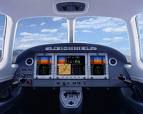 A software update to the Eclipse 500 jet will solve a problem that was the subject of a recent FAA emergency airworthiness directive, Eclipse Aviation said on Tuesday. Earlier this month, two pilots on approach to Midway Airport in Chicago experienced a throttle failure, resulting in maximum uncontrolled thrust from both Pratt & Whitney Canada PW601F turbofan engines. Eclipse says its solution will increase the range limit of the throttle quadrant assembly to prevent the fault condition from occurring. The fix requires approval from the FAA. Eclipse also has updated the Eclipse 500 flight manual and quick reference handbook to include procedures for handling a similar incident. In the Midway incident, the FAA said, the pilot applied full throttle with enough force against the forward stops to exceed the design throttle position signal maximum range. The associated fault mode held the engine thrust settings at the last known throttle position, which was maximum. The pilots were able to land safely after shutting down one engine and declaring an emergency.
A software update to the Eclipse 500 jet will solve a problem that was the subject of a recent FAA emergency airworthiness directive, Eclipse Aviation said on Tuesday. Earlier this month, two pilots on approach to Midway Airport in Chicago experienced a throttle failure, resulting in maximum uncontrolled thrust from both Pratt & Whitney Canada PW601F turbofan engines. Eclipse says its solution will increase the range limit of the throttle quadrant assembly to prevent the fault condition from occurring. The fix requires approval from the FAA. Eclipse also has updated the Eclipse 500 flight manual and quick reference handbook to include procedures for handling a similar incident. In the Midway incident, the FAA said, the pilot applied full throttle with enough force against the forward stops to exceed the design throttle position signal maximum range. The associated fault mode held the engine thrust settings at the last known throttle position, which was maximum. The pilots were able to land safely after shutting down one engine and declaring an emergency.
Eclipse also announced on Tuesday that of all the Eclipse 500 aircraft in customer operation, more than 80 percent have been inspected as directed by the AD. Of this group of inspected aircraft, seven have reported fault errors. Four of those seven fault reports were determined to be erroneous due to noise caused by normal operation of the throttle quadrant assembly. “Interestingly, an analysis of more than 12,000 hours of flight data from across our fleet collected through the Eclipse Flight Operational Quality Assurance (FOQA) system reveals that three Eclipse 500 aircraft have experienced the TQA range exceedance fault, and one was the aircraft in Chicago,” said Eclipse CEO Vern Raburn. “While this tells us there is an extremely low probability of this fault happening, we are moving very aggressively to ensure it will not occur again. We’re working closely with both the staff members of the NTSB and the FAA to understand this condition fully, and put the necessary design improvements in place to safeguard our customers and our fleet.”


































